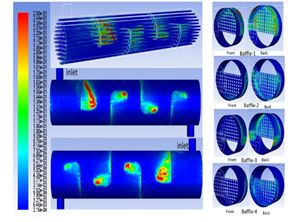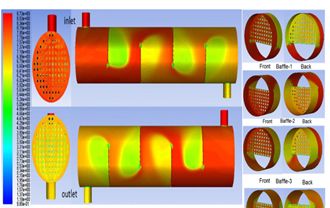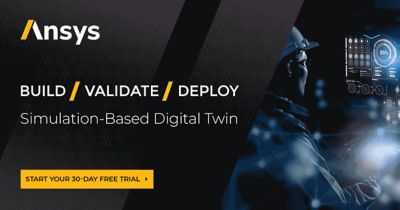-
-
Access Free Student Software
Ansys empowers the next generation of engineers
Students get free access to world-class simulation software.
-
Connect with Ansys Now!
Design your future
Connect with Ansys to explore how simulation can power your next breakthrough.
Countries & Regions
Free Trials
Products & Services
Learn
About
Back
Products & Services
Back
Learn
Ansys empowers the next generation of engineers
Students get free access to world-class simulation software.
Back
About
Design your future
Connect with Ansys to explore how simulation can power your next breakthrough.
Free Trials
ANSYS BLOG
January 21, 2022
Predict the Future with Ansys Twin Builder
Informed by a virtual working model of their designs, engineers can optimize performance across the entire product lifecycle.
The dividends of digital twins can be enormous. Companies can perform predictive maintenance to schedule repairs before any losses are incurred from equipment downtime. They can study and adjust operating parameters to maximize equipment efficiency, while also minimizing the impacts of vibration and other causes of failure. They can also feed real-world performance results back to the product development team to support continuous design improvements.
Digital twins enable engineers to take the concept of virtual prototyping one step further by building, validating, and deploying a working product prototype. Digital twins are emerging as a critical competency today, and with good reason. In fact, according to a recent report by ResearchandMarkets, the worldwide market for digital twin technologies is expected to exceed $63 billion by 2027, reflecting a growth rate of 41.7%.
Digital Twins Maximize Performance, Return on Investment
Digital twins leverage recent innovations in advanced embedded sensors to gather real-time performance data that accurately documents what’s happening in the field as the product operates. This data is relayed to engineering simulation software, where these same conditions are applied to a virtual model of the product. Engineers can visualize how their designs actually perform in the field, over time — including critical internal conditions such as fluid flows, as well as invisible changes like thermal increases and materials degradation.
Without taking actual products out of service, digital twins enable organizations to study virtually every aspect of product performance and optimize it. Informed by artificial intelligence (AI), the digital twin simulation paradigm positions companies to dramatically increase the efficiency and financial return of their physical assets over time, minimize downtime by strategically scheduling maintenance, and reduce their overall operating costs
Ansys Drives Ongoing Innovations for Digital Twins
Ansys Twin Builder is a multi-technology platform with an intuitive user interface that makes the process of creating, verifying, and deploying a digital twin seamless and accessible for even non-experts. The open, vendor-agnostic Ansys platform underlying Twin Builder enables it to seamlessly integrate with the range of sensors, physics solvers, databases, and libraries needed to create and run a virtual, fully functional product model.
Backed by the broad Ansys physics portfolio, Twin Builder accurately represents and applies the complex physical forces that act on working products, including hydraulic, thermal, mechanical, electrical, and other effects. Ansys software has the power and fidelity to accurately model complex relationships, a range of fluids, and both transient and steady states. Engineers can explore causality and failure modes, and make deterministic decisions using a proven, physics-based lens that eliminates guesswork.

By incorporating sensor inputs from the working product with a dynamic virtual product model, Ansys Twin Builder accurately replicates field conditions over time, so engineers can optimize lifecycle performance.
In addressing issues like wear and fatigue, Ansys Twin Builder also allows maintenance and repair engineers to run “what-if” scenarios and predict the success of any remediation strategies before enacting them on the actual, operating product.
Robust sensor simulation capabilities in Twin Builder support deployment use cases in which real-world, physical sensors are complemented by virtual sensors. This is essential in filling any gaps in looking at holistic, system-level product performance over time.
Finally, Ansys is unique in its use of state-of-the-art reduced-order modeling (ROM), which simplifies the computational complexity of mathematical models to produce faster run times, without sacrificing analytic rigor. ROM supports rapid design of experiments and parameter sweeps, while significantly decreasing solution times and storage requirements. Via ROM, simulation run times can be reduced from hours to seconds.
Twin Builder at Work: Modeling a Heat Exchanger
Recently, Twin Builder was used to model a heat exchanger, which is a mission-critical component of many heating and cooling applications. Corrosion, as well as fouling, mechanical fatigue, vibration, and buckling are common failure modes for these devices. The effects of all these phenomena often result in costly equipment downtime, as well as high maintenance and repair expenses.


Ansys Twin Builder helps identify potential failure modes such as fouling (left) and corrosion (right) on an industrial heat exchanger before these problems impact the product system’s performance.
By building, verifying, and deploying a digital twin of this heat exchanger, the engineering team can increase its efficiency, consequently reducing operating costs and emissions. The team can also predict time to maintenance via virtual sensors that monitor conditions that result in suboptimal performance and eventual failure.
Engineers can also predict the heat exchanger’s remaining useful life at any given point. If needed, operating parameters can be adjusted to support a longer life or more effective performance. For example, engineers can study and address any sources of acoustic vibration, whether internal or external to the exchanger.
Making Digital Twins Practical and Accessible
Many Ansys customers have expressed interest in exploring the concept of a digital twin. For those companies that haven’t yet implemented digital twins, there can be significant challenges, including the cost and effort required to install and maintain physical sensors across multiple facilities and physical assets, as well as the lack of engineering knowledge about equipment that have been running in the field for a certain amount of time.
However, the new hybrid calibration capabilities pioneered by Ansys, in which simulation-based digital twins are enriched with physical sensor information, was designed to address these obstacles. With digital twins, customers can implement virtual sensors, thereby reducing the number of physical sensors and associated costs. The digital twins can be deployed at scale to track the different equipment’s operation in a wide range of different conditions. Furthermore, each deployed twin can be calibrated based on the data monitored from its connected asset. This ensures that the digital twin is as close as possible to the actual as-operated asset, and any possible deviation is captured (for example, due to aging, which in general cannot be determined from usual engineering knowledge).
Over the past five years of focused development, Ansys has proven the abilities of digital twins to unlock significant top- and bottom-line benefits for a wide range of customers, helping to avoid expensive asset failure, process downtime, and over-maintenance of equipment. With its expertise in physics-based simulation, which is at the heart of the digital twin concept, Ansys is uniquely qualified to help customers leverage the benefits of digital twins for their own critical product applications.
Watch our on-demand webinar “Build, Validate and Deploy Your Digital Twins for Heat Exchanger Applications” or request your free trial of Ansys Twin Builder today!
